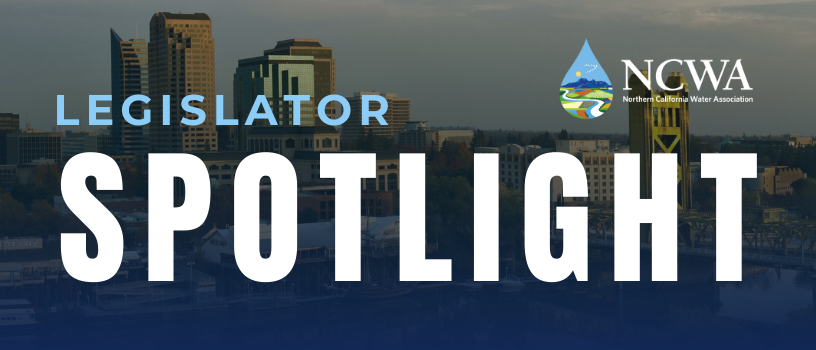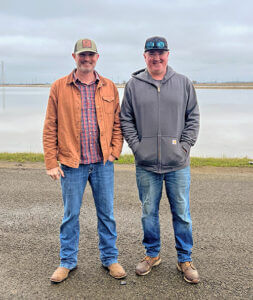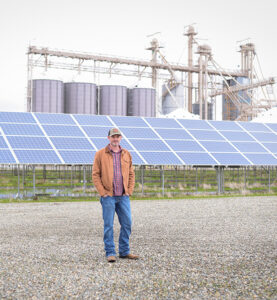
 ASSEMBLYMEMBER JAMES GALLAGHER
ASSEMBLYMEMBER JAMES GALLAGHER
Serving the following counties in Northern California: Butte, Glenn, Placer, Sutter, Tehama, Yuba.
In this Q&A, Assemblymember James Gallagher shares insights on California’s most pressing water and agricultural challenges, drawing from his background as a sixth-generation farmer and Minority Leader of the State Assembly. From modernizing water management to fostering collaborative solutions, Gallagher discusses his vision for balancing the needs of farmers, communities, and the environment, while preserving California’s agricultural heritage for future generations.
PATH TO PUBLIC SERVICE
Question: You come from a family with a strong legacy in farming and public service. What inspired you to take the step into the legislative arena, and how does your family background influence your approach to leadership and policy?
Answer: My grandpa played a big role in inspiring me to get involved in public service. He always emphasized the importance of leaving your community better than you found it, standing up for its needs, protecting our values, and defending our rights. Those lessons stayed with me and influenced my decision to enter public service. My first role was as a County Supervisor in Sutter County. During that time, I saw firsthand how state policies impact everything we do at the local level and, frankly, how they often handcuff us. That experience was a catalyst for me to run for state office. I wanted to change the way things are done in Sacramento and be a voice for our community.
CONNECTION TO THE SACRAMENTO VALLEY
Question: As someone deeply rooted in the Sacramento Valley, what do you cherish most about this region?
Answer: It’s the land and the people. The landscape here is absolutely beautiful—from the Sutter Buttes to the rice fields, the cattle country, and the foothills. I represent such a diverse and scenic part of the state, and every time I travel through the district, I feel incredibly blessed. Beyond the natural beauty, it’s the sense of community that stands out. Each town is unique, and there’s space between them that offers a sense of breathing room and preserves the rural character of the region.
The people here are incredibly resilient and generous. For example, when disasters like the Camp Fire happened, the community rallied together in amazing ways to recover and rebuild. They also come together to raise support when someone falls ill or a school program needs funding. That spirit extends to larger efforts like protecting this beautiful region and preserving our way of life. That resilience has been a hallmark of this area. We’re not the wealthiest region, but we’re rich in community and spirit, and I’m proud to represent that.

WATER MANAGEMENT AND DROUGHT
Question: As a sixth-generation farmer, what challenges have you personally experienced with water access, especially during drought years? How have these challenges shaped your legislative priorities?
Answer: Like many farmers, we’ve faced significant challenges with water access. During drought years, we relied heavily on groundwater, which is expensive and must be carefully managed. We also had to fallow land at times, a tough decision that affects both operations and employees.
These experiences have shaped my focus on good water management and upgrading water systems, building reservoirs like Sites Reservoir, and improving infrastructure. We also need to store excess water during wet years and adapt to California’s cycles of floods and droughts. Bipartisan efforts are essential to modernize our water management and ensure long-term sustainability for everyone.
Question: California’s water infrastructure is under considerable strain. What are your thoughts on modernizing California’s water management system to better support farmers, communities, and ecosystems?
Answer: The system needs much more flexibility. Right now, the way the State Water Resources Control Board and the Bureau of Reclamation manage water doesn’t make sense. Unimpaired flow requirements don’t account for the need to create riparian habitats, which are crucial for the environment. We need to adjust our approach and give agencies more direction to work toward practical solutions.
For example, we need to better use flood flows by diverting them into storage facilities and groundwater banks. We also need to modernize how we operate our existing reservoirs. Many of these operations are still based on manuals from the 1950s, which is outdated given today’s challenges. Updating these systems would allow us to better meet the needs of farmers, ensure safe drinking water, and support environmental goals.
FARMING AND AGRICULTURE POLICY
Question: Given your background in rice and walnut farming, what would you like urban Californians to better understand about the water needs and contributions of farmers in the state?
Answer: California’s farmers are essential for our state, our country, and the world. They produce safe, nutritious food that’s vital for food security, but rising costs, a tough regulatory environment, and stagnant commodity prices are putting their future at risk. On our current path, we could lose many farms in the next two decades, and much of that land could be developed— which would hurt local communities, increase flood risks, eliminating critical floodplains, wildlife habitat, and open spaces as farmland is developed.
California uses its water to grow crops that feed people worldwide—something we should be proud of. There are only a few places where crops like walnuts and rice can thrive, and California’s unique climate, soil and water access make it one of them. Supporting farmers ensures we continue producing the wholesome, safe food humans depends on while preserving the lands that protect our environment and communities.
Question: With Climate Change Intensifying, how do you envision the future of farming in California? What role does the state government have in supporting sustainable agricultural practices?
Answer: Farmers in California have historically been sustainable and adaptable. Each farmer evaluates their land, water, and conditions to decide what works best. Mandating how to farm isn’t effective and often feels overreaching. Instead, government should partner with farmers to provide tools and resources that enhance sustainability and long-term productivity. Collaboration ensures farming remains viable for future generations. Farmers already do many of the things people advocate for, like using fewer inputs and protecting their land for long-term use, even if those efforts go unnoticed. Ultimately, farmers want their lands to be healthy and productive for generations to come, because their families and community depend on it.
COLLABORATIVE WATER SOLUTIONS
Question: There’s a strong push for partnerships between the agricultural sector, environmental groups, and local governments for more collaborative water solutions. How do you see these partnerships evolving, and what role do you see yourself playing in facilitating such alliances?
Answer: Collaboration is already happening between farmers, local governments, environmental groups, and Native tribes. In the Sacramento Valley, we’ve seen significant partnerships develop around groundwater management, where agencies, water districts, and farmers have come together to create practical plans. These efforts are much better than top-down mandates from the state.
As a legislator, my role is often to bring people to the table to foster dialogue. I’ve worked to ensure agencies understand our perspectives and that we receive the flexibility and responsiveness we need. My staff and I stay engaged in discussions, gather information, and translate that into actionable steps to improve government responsiveness and problem-solving.
BALANCING WATER NEEDS FOR URBAN AND RURAL AREAS
Question: With the growing urban demand for water, how can California balance the water needs of agriculture and urban areas, especially given the state’s fluctuating water supply?
Answer: Balancing water needs starts with better water management. Diverting flood flows into storage facilities and groundwater banks can exponentially increase water availability for both urban and agricultural areas.
Land use planning is also critical. Urban growth should focus on areas around existing cities where infrastructure already exists and can be modernized or expanded. This prevents unnecessary development in prime farm country, which is essential for food production and environmental benefits. Keeping a smart balance between growth and preservation is key to ensuring we have the water and resources needed for everyone.
 LEADERSHIP AND POLICY PRIORITIES
LEADERSHIP AND POLICY PRIORITIES
Question: As Minority Leader, what bipartisan efforts have you found most promising in addressing water challenges? Are there any unexpected alliances that have formed around water and agricultural issues?
Answer: Bipartisan collaboration has been crucial in water policy. For example, the passage of the water bond involved a strong coalition of legislators from both sides. Efforts to allocate funding for projects like Sites Reservoir also brought together urban and rural legislators who recognized the importance of modernizing water infrastructure for the entire state. These partnerships show that, when it comes to water, we can find common ground to address shared challenges.
ENVIRONMENTAL AND WILDLIFE CONSIDERATIONS
Question: The relationship between agricultural water use and environmental conservation is often complex. How can California continue supporting habitat restoration efforts without placing excessive strain on its agricultural communities?
Answer: Voluntary partnerships with farmers are the most effective way to achieve conservation goals. Many farms already have conservation easements or participate in mitigation banks, which provide environmental benefits while allowing farming to continue. These approaches work better than mandates.
The voluntary agreements show real promise for improving water management and enhancing habitats. When bureaucratic processes adapt to support collaboration, everyone benefits. Farmers care deeply about their land and want to preserve it for future generations, and partnerships are the best way to achieve multiple benefits for both agriculture and the environment.
TRIBAL ENGAGEMENT
Question: You have been a leader in tribal engagement in the Sacramento Valley and California. What are your thoughts on how tribes can better engage on water issues and develop partnerships with the farmers and conservationists in the Sacramento Valley?
Answer: Building relationships with tribes has been one of the most rewarding parts of my work. Recently, I met with the Miwok Tribe and learned about their history and connection to the Sacramento River. It was a reminder of the shared love for this land and the opportunities for collaboration.
We had productive discussions about water management and voluntary agreements that could benefit everyone. Tribes have historically been excluded from these conversations, and it’s crucial to bring them to the table. Water is deeply important to their communities, and by working together, we can create solutions that respect tribal sovereignty and benefit the broader region. This is a partnership I’m proud to help facilitate, and I look forward to continuing this important work.
 YOUTH AND AGRICULTURAL ENGAGEMENT
YOUTH AND AGRICULTURAL ENGAGEMENT
Question: Many young Californians are interested in sustainable agriculture and environmental stewardship. What advice would you give to young people in your district who want to pursue a career in farming or environmental policy?
Answer: If you’re from an agricultural background, I encourage you to seek an education and bring new perspectives back to the farm. For those outside of agriculture, spend time in the fields and learn how farming works firsthand—that experience is invaluable.
Farmers are always striving to improve, but it’s important to approach this work with humility. Too often, people come into agriculture with ideas without understanding the realities farmers face. The best way to contribute to sustainable agriculture is by listening, learning, and collaborating to find solutions that work for everyone.
Download a PDF version of this story here.




